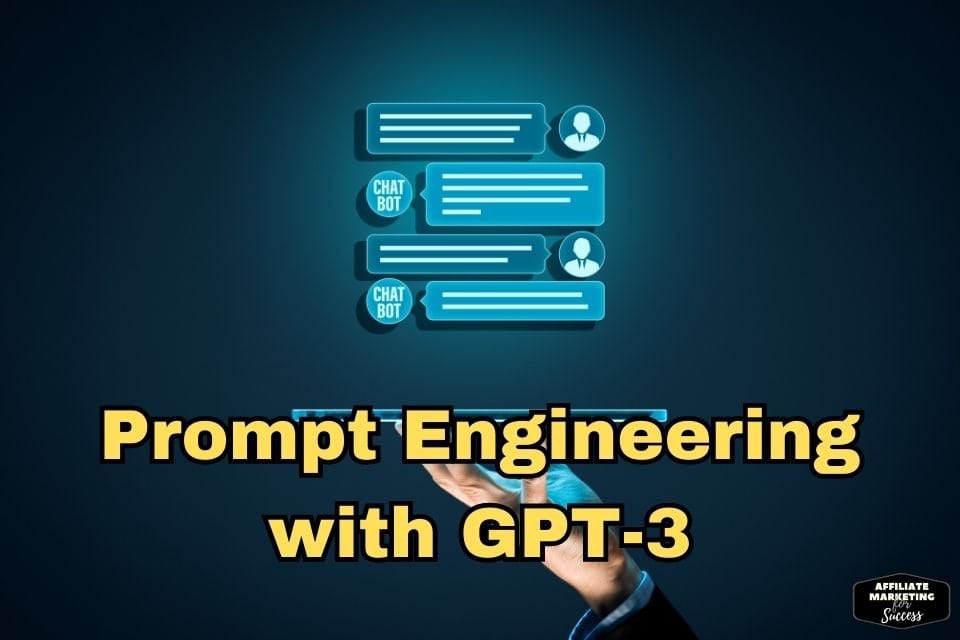GPT-3 Prompt Engineering: Boost AI Responses in 2024
Master Prompt Engineering with GPT-3: uncover secrets to harness AI power, unlock precise answers, and revolutionize your interactions with language models!
In the rapidly evolving field of artificial intelligence (AI), one breakthrough has captured the attention of engineers and developers worldwide – GPT-3. Standing for “Generative Pre-trained Transformer 3,” GPT-3 is a state-of-the-art language model developed by OpenAI. This powerful AI model has revolutionized many industries, including engineering, by streamlining workflows and enhancing productivity.
The Art of Prompt Engineering
| Key Idea | Description |
|---|---|
| Understand the Task | Clarify exactly what you want GPT-3 to do. Break down complex tasks into simpler instructions. |
| Use Natural Language | Write prompts conversationally, as if instructing a human. Avoid coding jargon. |
| Provide Examples | Include 2-4 examples that model the desired output format and content. |
| Guide the Model | Give context to prime GPT-3. Highlight important info. Ask questions. |
| Iterate and Refine | View generated outputs. Tweak prompts based on results. |
| Check for Hallucinations | Assess if outputs are factual, coherent and aligned with the prompt. |
| Simplify and Streamline | Remove unnecessary complexity. Use clear, minimal prompts for efficiency. |
What is GPT-3 and Why is it a Big Deal?
GPT-3 represents a significant advancement in natural language processing (NLP) technology. It is designed to generate human-like responses based on given prompts or questions, making it an invaluable tool for engineers seeking efficient solutions. With its ability to understand context, generate coherent text, and perform numerous language-related tasks, GPT-3 has quickly become a game-changer in the engineering industry.
How does GPT-3 Work?
At its core, GPT-3 consists of a massive neural network trained on diverse internet text sources. It leverages transformer architecture to process and understand vast amounts of data effectively. The model uses unsupervised learning to develop an understanding of language patterns, allowing it to generate coherent and contextually relevant responses.
Highlighting Main Features and Capabilities of GPT-3
GPT-3 boasts several remarkable features that have contributed to its widespread adoption in the engineering field:
Natural Language Understanding
One of the most impressive aspects of GPT-3 is its ability to comprehend and interpret natural language inputs with exceptional accuracy. By understanding user intent and context, this AI model can provide accurate responses tailored to specific engineering requirements.
Multilingual Support
GPT-3 supports multiple languages, making it accessible to engineers across different regions globally. Its versatility in understanding various languages enables efficient communication and collaboration among professionals from diverse backgrounds.
Contextual Understanding
With its deep understanding of context, GPT-3 can maintain coherence and generate responses that align with the given prompt or query. This contextual understanding makes it an invaluable tool for engineers seeking accurate and relevant information.
Creative Text Generation
GPT-3 is known for its ability to generate creative and engaging text. It can produce well-written reports, technical documents, and even code snippets based on provided prompts. This feature significantly enhances productivity in engineering tasks that involve written communication.
Applications and Use Cases of GPT-3 in Engineering
GPT-3 has found extensive applications across various engineering domains. Some notable use cases include:
Mechanical Engineering
Engineers in the field of mechanical engineering leverage GPT-3 to automate design processes, optimize product performance, and simulate complex systems. Using natural language prompts, GPT-3 can generate innovative design ideas and offer valuable insights into manufacturing processes.
Civil Engineering
In civil engineering, GPT-3 aids professionals in structural analysis, feasibility studies, and environmental impact assessments. By providing accurate data analysis and predictive modeling capabilities, GPT-3 assists engineers in making informed decisions related to construction projects.
Electrical Engineering
Electrical engineers benefit from GPT-3’s ability to assist in circuit design optimization, fault diagnosis, and intelligent system development. By generating detailed technical documentation and offering solutions to complex problems, GPT-3 streamlines the electrical engineering workflow.
Limitations and Challenges of GPT-3
While GPT-3 offers remarkable capabilities for prompt-based engineering tasks, it still faces certain limitations:
Context Sensitivity
Although highly proficient at generating coherent text based on prompts, GPT-3 sometimes struggles with context sensitivity. It may occasionally provide responses that lack specific details or fail to address nuanced aspects of a given task.
Data Dependency
GPT-3 heavily relies on the training data it was exposed to, which poses challenges when encountering domains or topics it has not extensively learned. It may generate inaccurate or misleading information in such cases.
Ethical Considerations
Ethical considerations are crucial with any powerful AI model when using GPT-3. Engineers must ensure the prompts and instructions align with ethical standards to avoid potential biases or unintended consequences in the generated outputs.
Check Out: ChatGPT Use Cases: Connecting Personal, Business, and Niche Needs in the Digital Age
What is Prompt Engineering and Why Does it Matter?

As an expert in AI, I believe that one of the most exciting developments in the field is the emergence of prompt engineering and its application to large language models like GPT-3. This language model, developed by OpenAI, has taken the AI revolution to a new level, capable of generating natural language responses that are often indistinguishable from human-written text.
With the right prompt engineering techniques, you can guide the model to generate text for specific use cases, from generating code to responding to questions. The process involves passing a prompt to the model to help it understand what you want it to do and then fine-tuning the output to match the desired results.
What is Prompt Engineering in GPT-3?
If you want to generate high-quality language output with GPT-3, you’ll want to pay attention to prompt engineering. Prompt engineering is all about crafting specific prompts for the GPT-3 language model that maximize its ability to generate responses that align with your desired output. In other words, prompt engineering is a technique that allows you to guide the model to provide output that is specific to your needs.
GPT-3, developed by OpenAI, is one of the most advanced and versatile language models. As an AI model, GPT-3 can learn how to use language and generate natural language output based on the input it receives. But while the model can generate text independently, using specific prompts can help the model produce even better output.
With prompt engineering techniques, users can guide a machine learning model such as GPT-3 to produce specific responses to questions or generate code. The process involves crafting a specific prompt passed to the model, upon which it generates the output. The most effective prompts are usually short and precise, communicating precisely what you want the model to generate.
Mastering Prompt Engineering: Unlock the Power of GPT-3 with OpenAI Playground

How Prompt Engineering Works with GPT-3
Prompt engineering encompasses several key steps:
Understand Your Task and User Intent
Before designing prompts, engineers must clearly understand the task at hand and the intended outcome. Identifying the task type and user intent helps choose appropriate models and parameters for optimal results.
Choose the Appropriate Model and Parameters
GPT-3 offers various models with different capabilities and sizes. Engineers should select the most suitable model based on their specific needs. Adjusting parameters such as temperature (controlling randomness) and max tokens (limiting response length) can also fine-tune the output.
Use Natural Language and Clear Instructions
To obtain accurate responses from GPT-3, prompts should be formulated using natural language that aligns with how humans interact. Clear instructions provide clarity to the model, resulting in more precise outputs.
Check Out: Unlock Prompt Engineering Secrets: AI Magic Revealed!
How Does Prompt Engineering Improve GPT-3’s Performance?

GPT-3, an AI-based language model developed by OpenAI, has caused a sensation in the AI community since its release. It can generate natural language output that’s often difficult to distinguish from human-generated text. It can be used for various applications, including chatbots, content generation, and more. However, making the most of GPT-3 requires specialized techniques called prompt engineering.
Benefits of Prompt Engineering with GPT-3
Effective prompt engineering offers numerous benefits for engineers utilizing GPT-3:
- Improved Accuracy: Well-designed prompts increase the likelihood of receiving accurate responses from GPT-3.
- Enhanced Relevance: By providing relevant context through prompts, engineers can ensure that generated outputs align with their specific requirements.
- Time Efficiency: With properly engineered prompts, engineers can save time by avoiding unnecessary iterations or incorrect responses.
- Streamlined Workflow: Prompt engineering optimizes the interaction between engineers and GPT-3, resulting in a more efficient workflow.
Challenges of Prompt Engineering
While prompt engineering offers significant advantages, it also presents challenges that engineers must overcome:
- Iterative Refinement: Designing effective prompts often involves iterative refinement through testing and evaluation to achieve the desired outcomes.
- Fine-tuning for Specific Tasks: Certain engineering tasks may require customizations or fine-tuning of prompts to obtain precise results.
- Balancing Complexity and Simplicity: Engineers need to balance providing sufficient context and keeping prompts concise for optimal performance.
Using ChatGPT and OpenAI Playground
OpenAI provides an online playground that allows users to experiment with the GPT-3 language model. This allows users to explore the model’s capabilities and experiment with prompt engineering techniques. Using the OpenAI playground and exploring different prompt engineering techniques can significantly improve GPT-3’s performance.
One of the best ways to get started with prompt engineering is to use ChatGPT, a web application that allows users to interact with GPT-3 models via conversational input. This helps users understand the interplay between different prompts, outputs, and the model’s response to various inputs.
The Power of Few-Shot and Zero-Shot Learning
GPT-3’s remarkable abilities are partly due to its large language model and sophisticated machine-learning algorithms. The model can learn from few-shot examples and generalize to new tasks in a process known as zero-shot learning.
Prompt engineering techniques help the model to learn from fewer examples and generalize more effectively. For example, if a specific prompt is being used repeatedly, a model can learn from fewer data points, significantly speeding up the learning process.
Best Practices for Effective Prompt Engineering
For the best results in prompt engineering, several best practices should be followed:
- Design prompts that are clear and specific
- Use natural language that humans and AI easily understand.
- Experiment with different prompts to identify the most effective ones
- Fine-tune prompts to improve accuracy and reduce noise
Check Out: ChatGPT: Revolutionary Chatbot by Open AI
Challenges in Implementing Prompt Engineering for GPT-3

While GPT-3 is undeniably a ground-breaking technological achievement, it has limitations. One of the primary challenges in implementing prompt engineering for GPT-3 is dealing with the complexity of the model’s output. The model’s natural language processing abilities are impressive but can lead to unpredictable and sometimes nonsensical responses. This complexity can make fine-tuning prompts to generate accurate and relevant outputs difficult.
Another challenge is the lack of understanding of how the model works. GPT-3 is a large language model with 175 billion parameters, making it almost impossible to comprehend how it generates its output. This lack of transparency can make diagnosing and correcting errors in the model’s behavior challenging.
Despite these challenges, several best practices can be employed to overcome them. For example, a few-shot or zero-shot learning approach can help the model understand the context and generate more relevant output. Effective prompts that guide the model’s behavior by providing specific context, entities, or constraints -passed to the model- can be created to provide better outcomes.
Check Out: ChatGPT vs. Competing Language Models
Using ChatGPT, an API for GPT-3
OpenAI provides an API called ChatGPT, prebuilt conversational agent developers can use to get started with GPT-3. ChatGPT is a great starting point for developers to understand how the GPT-3 model works and how to create effective prompts. Moreover, OpenAI has created an incredibly powerful OpenAI Playground, where developers can experiment with prompts and the model’s output to understand better how it works.
In conclusion, prompt engineering for GPT-3 is critical to fully realizing the potential of this revolutionary AI model. By following best practices and experimenting with different approaches, developers can create effective prompts that guide the model toward producing accurate and relevant output. Whether using ChatGPT, experimenting with the OpenAI Playground, or developing specific prompts, AI enthusiasts can use prompt engineering to help AI understand natural language better and tackle different use cases.
Check Out: How ChatGPT Works Unveiled: An In-Depth Look
How to Use ChatGPT for Prompt Engineering?
ChatGPT is an API created by OpenAI that uses GPT-3 to chat with users. You can use ChatGPT for prompt engineering by inputting a specific prompt and then fine-tuning the output based on your feedback. Here are some best practices for using ChatGPT for prompt engineering:
- Start with a specific prompt. Be clear about the context and what you want the model to accomplish.
- Use relevant tokens. Use tokens related to the prompt’s context to help the model generate more accurate responses.
- Try few-shot learning. Fine-tune the output based on a few examples rather than a large dataset.
- Use zero-shot learning. Use the model’s ability to generate responses to unseen prompts.
Check Out: Discover The Power Of ChatGPT
Output of GPT-3 for Prompt Engineering
GPT-3 generates text that is often indistinguishable from human-written text. The model takes a prompt and generates a natural language response that fits the input context. The output can be fine-tuned based on feedback to meet specific requirements.
Best Practices for Effective Prompt Engineering
Prompt engineering is a powerful tool for generating natural language responses that meet specific needs. Here are some best practices for effective, prompt engineering:
- Start with a specific prompt that defines the context and what you want the model to accomplish.
- Use relevant tokens that relate to the context of the prompt to help the model generate more accurate responses.
- Fine-tune the output based on feedback to meet specific requirements.
- Use few-shot learning to fine-tune the model based on a few examples.
- Use zero-shot learning to generate responses to unseen prompts.
How to Design Effective Prompts for GPT-3
Designing effective prompts is crucial for obtaining accurate and relevant responses from GPT-3. Following these steps can help engineers create well-crafted prompts:
Understand Your Task and User Intent
To design an effective prompt, engineers must first understand the task they want GPT-3 to perform and the user intent behind it. This understanding helps in formulating clear instructions that align with the desired outcome.
Identify Your Task Type and User Intent
Identifying the task type (e.g., text generation, data analysis, code generation) allows engineers to choose an appropriate model and set parameters accordingly. Understanding user intent ensures that the prompt addresses specific requirements.
Use Natural Language and Clear Instructions
When crafting prompts, engineers should use natural language that clearly communicates their requirements. Concise yet explicit instructions help GPT-3 generate accurate responses.
Provide Relevant Context and Examples
Providing relevant context is essential for eliciting precise responses from GPT-3. Engineers should include background information that aids the model in understanding the problem at hand. Additionally, using few-shot or zero-shot examples can guide GPT-3 in generating appropriate outputs.
Use Formatting and Tags to Structure Your Prompt
Formatting and tags can help structure the prompt, making it more readable and understandable for GPT-3. Engineers can use headings, bullet points, or other formatting techniques to clarify and enhance the prompt’s effectiveness.
Test and Refine Your Prompt
Testing the prompt with different inputs and evaluating the outputs is crucial for refining its effectiveness. Engineers should assess accuracy, relevance, quality, and other desired criteria to refine the prompt iteratively.
Tips and Tricks for Prompt Engineering with GPT-3
To further optimize prompt engineering with GPT-3, consider these tips and tricks:
Use Curiosity and Creativity
Experimenting with different prompts and tasks allows engineers to explore the full potential of GPT-3. Trying out various domains, topics, or input formats promotes creativity in prompt engineering.
Explore Logic and Reasoning
Leveraging logical operators, conditional statements, mathematical expressions, formulas, reasoning skills, and common sense enhances the capabilities of GPT-3. Incorporating these elements into prompts helps in achieving more complex engineering tasks.
Utilize Resources and References
External sources and references provide valuable support in enhancing prompt engineering. Engineers can consult existing prompts or templates as inspiration for designing effective prompts. Online tools and platforms offer additional resources to improve the overall experience of prompt engineering.
FAQs
What does prompt engineering with GPT-3 entail?
Prompt engineering with GPT-3 involves crafting specific input prompts to guide the AI in producing desired, accurate, and relevant output responses.
How does GPT-3 streamline workflows?
GPT-3 can automate tasks such as content generation, data analysis, and customer service interactions, enhancing efficiency and streamlining workflows.
Why is GPT-3 beneficial for prompt engineering?
GPT-3’s vast training data and ability to comprehend context benefit prompt engineering, as it can generate diverse, accurate responses.
Can GPT-3 improve productivity?
Yes, GPT-3 can significantly enhance productivity in various business areas by automating repetitive tasks and generating high-quality content.
Is it easy to integrate GPT-3 into existing workflows?
With the right APIs and technical support, GPT-3 can be effectively integrated into existing systems to optimize various workflows.
Conclusion

Prompt engineering is a powerful technique for guiding GPT-3 and other large language models to generate text that meets specific needs. With the right prompt engineering techniques, you can teach the model to think step by step and communicate like humans, making it a powerful tool for NLP and other machine-learning models. Whether you’re generating code, responding to questions, or asking the model to perform other tasks, prompt engineering can help you get started and get the desired results.
References
A Hands-on Guide to Prompt Engineering with ChatGPT and GPT-3
If you have played around with ChatGPT (or the GPT-3 models), you probably have noticed that the quality of the responses depends on how you ask the question. Usually, detailed …
Prompt Engineering Tips and Tricks with GPT-3 – andrew makes things
You interact with GPT-3, or its forthcoming competitors, through Prompt Engineering. In this post I’ll briefly explain what Prompt Engineering is, why it matters, and some tips …
Best practices for prompt engineering with OpenAI API
Best practices for prompt engineering with OpenAI API How to give clear and effective instructions to GPT-3 and Codex J Written by Jessica Shieh. Updated over a week ago 💡 …
Prompt Engineering in GPT-3 – Analytics Vidhya
What is GPT 3 prompt? A. GPT-3 prompt refers to a specific type of input used to generate text using the Generative Pre-trained Transformer 3 (GPT-3) language model. A prompt …
Prompt Engineering: The Ultimate Guide 2023 [GPT-3 & ChatGPT]
Prompt Engineering: The Ultimate Guide 2023 [GPT-3 & ChatGPT] Prompt engineering is one of the highest-income skills you can learn in 2023. Those equipped with it are …
Prompt Engineering for ChatGPT | Coursera
Students will start with basic prompts and build towards writing sophisticated prompts to solve problems in any domain. By the end of the course, students will have strong prompt engineering …
10 Amazing Resources For Prompt Engineering, ChatGPT, and GPT-3
Not really a prompt engineering resource per se but definitely interesting for the prompt engineer: as sort of a Neumann probe for GPT-3, this little tool lets you create custom …
OpenAI GPT-3 and Prompt Engineering | by swapp19902 – Medium
Jul 19, 2020. –. 2. OpenAI released its GPT-3 language model in June 2020. It was trained on 175 billion parameters, which is 10x more than their previous iteration …
I’m Alexios Papaioannou, an experienced affiliate marketer and content creator. With a decade of expertise, I excel in crafting engaging blog posts to boost your brand. My love for running fuels my creativity. Let’s create exceptional content together!
You Might Also Like
- This principle is further explored in our detailed examination of AI & Machine Learning: Boost Affiliate Marketing in 2025 AI & Machine Learning: Boost Affiliate Marketing in 2025.
- This concept relates closely to what we cover in our analysis of 7 Proven Generative AI Strategies for Affiliate Marketing Success 7 Proven Generative AI Strategies for Affiliate Marketing Success.
- For more insights on this topic, you might find our exploration of DeepSeek R1 vs ChatGPT: 7 Surprising AI Model Differences valuable DeepSeek R1 vs ChatGPT: 7 Surprising AI Model Differences.







